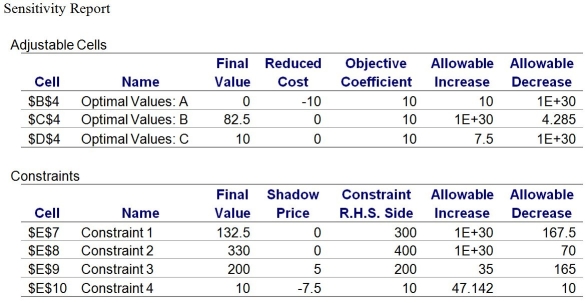Use this information,along with its associated Sensitivity Report,to answer the following questions.
A production manager wants to determine how many units of each product to produce weekly to maximize weekly profits.Production requirements for the products are shown in the following table.
Material 1 costs $7 a pound,material 2 costs $5 a pound,and labor costs $15 per hour.Product A sells for $101 a unit,product B sells for $67 a unit,and product C sells for $97.50 a unit.Each week there are 300 pounds of material 1;400 pounds of material 2;and 200 hours of labor.The output of product A should not be more than one-half of the total number of units produced.Moreover,there is a standing order of 10 units of product C each week.

-Suppose that we force the production of one unit of product A.The new objective function value will be
Definitions:
Employment Act of 1946
A United States federal law aiming to promote maximum employment, production, and purchasing power through economic stability policies.
Aggregate Demand
The total demand for final goods and services in an economy at a given time.
Theory of Liquidity Preference
A theory suggesting that individuals prefer to have their resources in liquid forms and how that preference influences interest rates.
Interest Rates
The cost of borrowing money, expressed as a percentage of the amount borrowed, paid by the borrower to the lender for using their money.
Q5: Suppose that the utility function for
Q9: Whenworkers representing aunion march at the entranceto
Q11: If a company produces Product A,then it
Q25: In goal programming,the objective is typically to
Q30: A human resource management system integrates which
Q31: Slack for a given activity is computed
Q37: Who among the following is most likely
Q39: Which of the following is the first
Q43: A beauty salon employs three hairdressers.All customers
Q45: Which of the following is the best